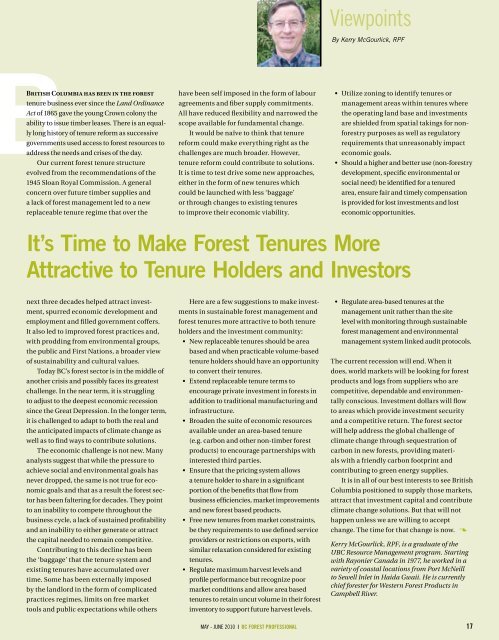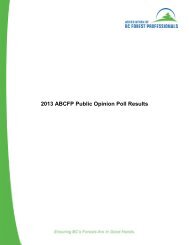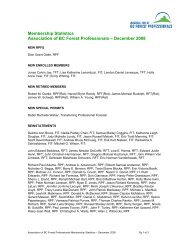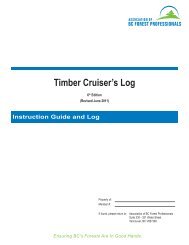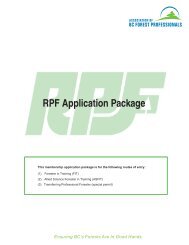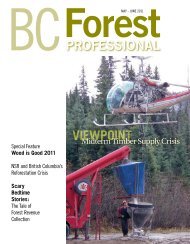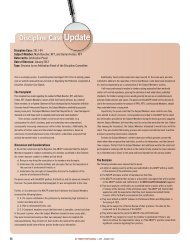VIEWPOINT - Association of BC Forest Professionals
VIEWPOINT - Association of BC Forest Professionals
VIEWPOINT - Association of BC Forest Professionals
Create successful ePaper yourself
Turn your PDF publications into a flip-book with our unique Google optimized e-Paper software.
British Columbia has been in the forest<br />
tenure business ever since the Land Ordinance<br />
Act <strong>of</strong> 1865 gave the young Crown colony the<br />
ability to issue timber leases. There is an equally<br />
long history <strong>of</strong> tenure reform as successive<br />
governments used access to forest resources to<br />
address the needs and crises <strong>of</strong> the day.<br />
Our current forest tenure structure<br />
evolved from the recommendations <strong>of</strong> the<br />
1945 Sloan Royal Commission. A general<br />
concern over future timber supplies and<br />
a lack <strong>of</strong> forest management led to a new<br />
replaceable tenure regime that over the<br />
next three decades helped attract invest-<br />
ment, spurred economic development and<br />
employment and filled government c<strong>of</strong>fers.<br />
It also led to improved forest practices and,<br />
with prodding from environmental groups,<br />
the public and First Nations, a broader view<br />
<strong>of</strong> sustainability and cultural values.<br />
Today <strong>BC</strong>’s forest sector is in the middle <strong>of</strong><br />
another crisis and possibly faces its greatest<br />
challenge. In the near term, it is struggling<br />
to adjust to the deepest economic recession<br />
since the Great Depression. In the longer term,<br />
it is challenged to adapt to both the real and<br />
the anticipated impacts <strong>of</strong> climate change as<br />
well as to find ways to contribute solutions.<br />
The economic challenge is not new. Many<br />
analysts suggest that while the pressure to<br />
achieve social and environmental goals has<br />
never dropped, the same is not true for economic<br />
goals and that as a result the forest sector<br />
has been faltering for decades. They point<br />
to an inability to compete throughout the<br />
business cycle, a lack <strong>of</strong> sustained pr<strong>of</strong>itability<br />
and an inability to either generate or attract<br />
the capital needed to remain competitive.<br />
Contributing to this decline has been<br />
the ‘baggage’ that the tenure system and<br />
existing tenures have accumulated over<br />
time. Some has been externally imposed<br />
by the landlord in the form <strong>of</strong> complicated<br />
practices regimes, limits on free market<br />
tools and public expectations while others<br />
have been self imposed in the form <strong>of</strong> labour<br />
agreements and fiber supply commitments.<br />
All have reduced flexibility and narrowed the<br />
scope available for fundamental change.<br />
It would be naïve to think that tenure<br />
reform could make everything right as the<br />
challenges are much broader. However,<br />
tenure reform could contribute to solutions.<br />
It is time to test drive some new approaches,<br />
either in the form <strong>of</strong> new tenures which<br />
could be launched with less ‘baggage’<br />
or through changes to existing tenures<br />
to improve their economic viability.<br />
Here are a few suggestions to make investments<br />
in sustainable forest management and<br />
forest tenures more attractive to both tenure<br />
holders and the investment community:<br />
• New replaceable tenures should be area<br />
based and when practicable volume-based<br />
tenure holders should have an opportunity<br />
to convert their tenures.<br />
• Extend replaceable tenure terms to<br />
encourage private investment in forests in<br />
addition to traditional manufacturing and<br />
infrastructure.<br />
• Broaden the suite <strong>of</strong> economic resources<br />
available under an area-based tenure<br />
(e.g. carbon and other non-timber forest<br />
products) to encourage partnerships with<br />
interested third parties.<br />
• Ensure that the pricing system allows<br />
a tenure holder to share in a significant<br />
portion <strong>of</strong> the benefits that flow from<br />
business efficiencies, market improvements<br />
and new forest based products.<br />
• Free new tenures from market constraints,<br />
be they requirements to use defined service<br />
providers or restrictions on exports, with<br />
similar relaxation considered for existing<br />
tenures.<br />
• Regulate maximum harvest levels and<br />
pr<strong>of</strong>ile performance but recognize poor<br />
market conditions and allow area based<br />
tenures to retain uncut volume in their forest<br />
inventory to support future harvest levels.<br />
may - june 2010 | <strong>BC</strong> FOREST PROFESSIONAL<br />
Viewpoints<br />
By Kerry McGourlick, RPF<br />
• Utilize zoning to identify tenures or<br />
management areas within tenures where<br />
the operating land base and investments<br />
are shielded from spatial takings for nonforestry<br />
purposes as well as regulatory<br />
requirements that unreasonably impact<br />
economic goals.<br />
• Should a higher and better use (non-forestry<br />
development, specific environmental or<br />
social need) be identified for a tenured<br />
area, ensure fair and timely compensation<br />
is provided for lost investments and lost<br />
economic opportunities.<br />
It’s Time to Make <strong>Forest</strong> Tenures More<br />
Attractive to Tenure Holders and Investors<br />
• Regulate area-based tenures at the<br />
management unit rather than the site<br />
level with monitoring through sustainable<br />
forest management and environmental<br />
management system linked audit protocols.<br />
The current recession will end. When it<br />
does, world markets will be looking for forest<br />
products and logs from suppliers who are<br />
competitive, dependable and environmentally<br />
conscious. Investment dollars will flow<br />
to areas which provide investment security<br />
and a competitive return. The forest sector<br />
will help address the global challenge <strong>of</strong><br />
climate change through sequestration <strong>of</strong><br />
carbon in new forests, providing materials<br />
with a friendly carbon footprint and<br />
contributing to green energy supplies.<br />
It is in all <strong>of</strong> our best interests to see British<br />
Columbia positioned to supply those markets,<br />
attract that investment capital and contribute<br />
climate change solutions. But that will not<br />
happen unless we are willing to accept<br />
change. The time for that change is now. 3<br />
Kerry McGourlick, RPF, is a graduate <strong>of</strong> the<br />
U<strong>BC</strong> Resource Management program. Starting<br />
with Rayonier Canada in 1977, he worked in a<br />
variety <strong>of</strong> coastal locations from Port McNeill<br />
to Sewell Inlet in Haida Gwaii. He is currently<br />
chief forester for Western <strong>Forest</strong> Products in<br />
Campbell River.<br />
17


